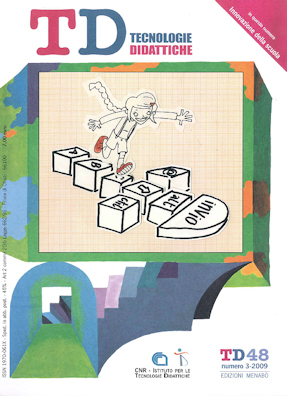What is involved in introducing new educational technologies in schools: a model
Main Article Content
Abstract
Article Details
Authors who publish with this journal agree to the following terms:
- Authors retain copyright and grant the journal right of first publication with the work simultaneously licensed under a Creative Commons CC BY 4.0 Attribution 4.0 International License.
- Authors are able to enter into separate, additional contractual arrangements for the non-exclusive distribution of the journal's published version of the work (e.g., post it to an institutional repository or publish it in a book), with an acknowledgement of its initial publication in this journal.
- Authors are permitted and encouraged to post their work online (e.g., in institutional repositories or on their website) prior to and during the submission process, as it can lead to productive exchanges, as well as earlier and greater citation of published work (See The Effect of Open Access)
References
Anglin G. J. (Ed) (1995). Instructional Technology: Past, present, and future. Englewood, CO: Libraries Unlimited.
Antonietti A., Colombo B. (2008). Computer-supported learning tools: A bicircular bi-directional framework. New Ideas in Psychology, 26, pp. 120- 142.
Boekaerts M., Pintrich P. R., Zeidner M. (Eds.) (2000). Handbook of self-regulation. San Diego, CA: Academic Press.
Breton. (2001). Le culte de l’Internet. Paris: La Découverte.
Bryant J., Zillman D. (Eds.) (2002). Media effects. Advances in theory and research. Mahwah, NJ: Lawrence Erlbaum Associates.
Dinet J., Marquet P., Nissen E. (2003). An exploratory study of adolescent’s perceptions of the Web. Journal of Computer Assisted Learning, 19, pp. 538-545.
Eilon B., Kliachko S. (2004). Perceptions of the teacher’s role by prospective elementary school science teachers in a Web-based biology course. Journal of Technology and Teacher Education, 12, pp. 339-360.
Gao T. (2003). The effects of different levels of interaction on the achievement and motivational perceptions of college students in a Web-based learning environment. Journal of Interactive Learning Reasearch, 14, pp. 367-386.
Gordon M., Killey M., Shevlin M., McIlroy D., Tierney K. (2003). The factor structure of the Computer Anxiety Rating Scale and the Computer Thoughts Survey. Computer in Human Behavior, 19, pp. 291-298.
Jiang M., Ting E. (2000). A study of factors influencing students’ perceived learning in a Web-based course environment. International Journal of Educational Telecommunications, 6, pp. 317-338.
Kozma R. B. (1994). Will media influence learning? Reframing the debate. Educational Technology Research and Development, 7, pp. 19-42.
Madell D., Muncer S. (2004). Back from the beach but hanging on the telephone? English adolescents’ attitudes and experiences of mobile phones and the Internet. Cyber Psychology and Behavior, 7, pp. 359-367.
Mimirinis M., Bhattacharya M. (2007). Design of virtual learning environments for deep learning. Journal of Interactive Learning Research, 18, pp. 55-64.
Munneke L., Andriessen J., Kanselaar G., Kirschner P. (2007). Supporting interactive argumentation: Influence of representational tools on discussing a wicked problem. Computers in Human Behavior, 23, pp. 1072-1088.
Narciss S., Proske A., Koerndle H. (2007). Promoting self-regulated learning in web-based learning environments. Computers in Human Behavior, 23, pp. 1126-1144.
Newby T., Stepich D., Lehman J., Russell J. (2000). Instructional Technology for teaching and learning: Designing instruction, integrating computers, and using media. Columbus, OH: Prentice-Hall.
Olimpo G. (1993). Nascita e sviluppi delle tecnologie didattiche. Tecnologie Didattiche, 1, pp. 23-34.
Saadé R. G., He X., Kira D. (2007). Exploring dimensions to online learning. Computers in Human Behavior, 23, 1721-1739.
Salomon G. (1993). On the nature of pedagogic computer tools: The case of the writing partner. In S. P. Lajoie, S. J. Derry (Eds), Computer as cognitive tools. Hillsdale, NJ: Erlbaum, pp. 179-196.
Selwyn N. (1997). Students’ attitudes toward computers: Validation of a computer attitude scale for 16-19 education. Computer and Education, 28, pp. 35-41.
Wang D., Lin S.S.J., Sun C. (2007). DIANA: A computer-supported heterogeneous grouping system for teachers to conduct successful small learning groups. Computers in Human Behavior, 23, pp. 1997-1010.
Wilson T., Whitelock D. (1998). What are the perceived benefits of participating in a computer-mediated communication (CMC) environment for distance learning computer science students? Computers and Education, 30, pp. 259-269.
Xiao L., Carroll J. M. (2007). Fostering an informal learning community of computer technologies at school. Behaviour and Information Technology, 26, pp. 23-26.
Yaghi H. M. (1997). Pre-university students’ attitudes toward computers: An international perspective. Journal of Educational Computing Research, 16, pp. 237-249

